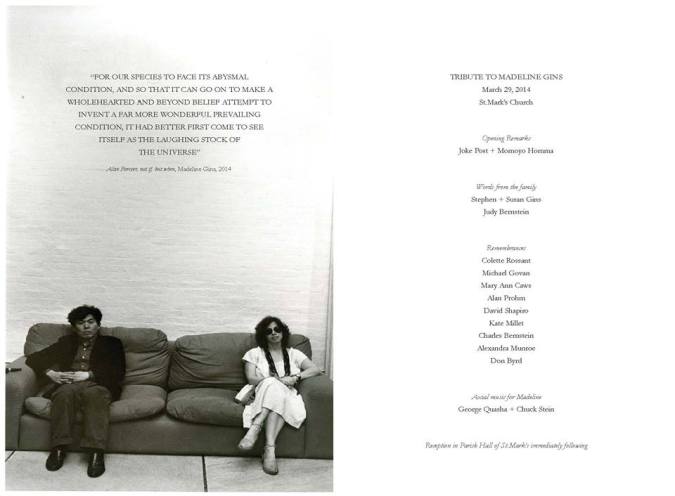Madeline Gins: 7 Nov. 1941 – 8 Jan. 2014 – RDIP – Reversing Destiny in Perpetuity
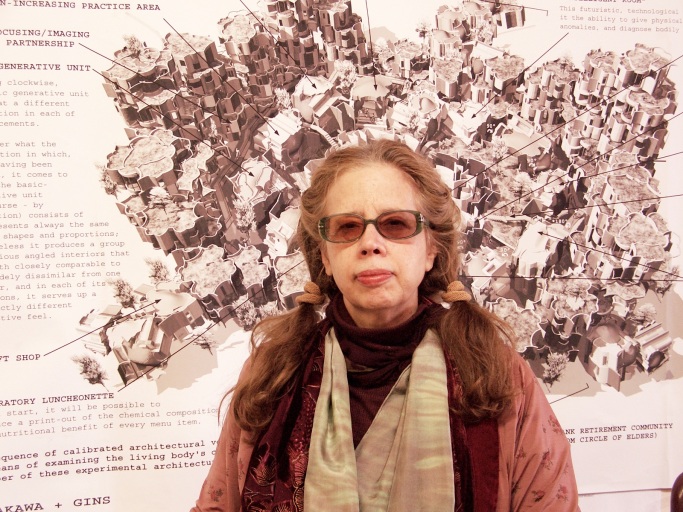 Madeline Gins: Lost the battle against dying, but still winning the war against giving up.
Madeline Gins: Lost the battle against dying, but still winning the war against giving up.
THE ME(MORE)RIAL:
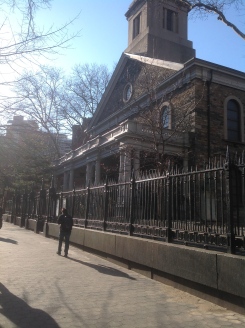
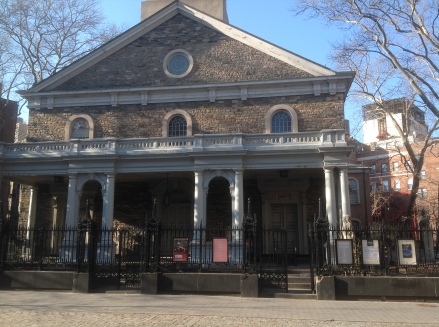 Memorial for Madeline Gins – 29.3.2014 St. Mark’s in the Bowery, NYC
Memorial for Madeline Gins – 29.3.2014 St. Mark’s in the Bowery, NYC
THE PROGRAM:
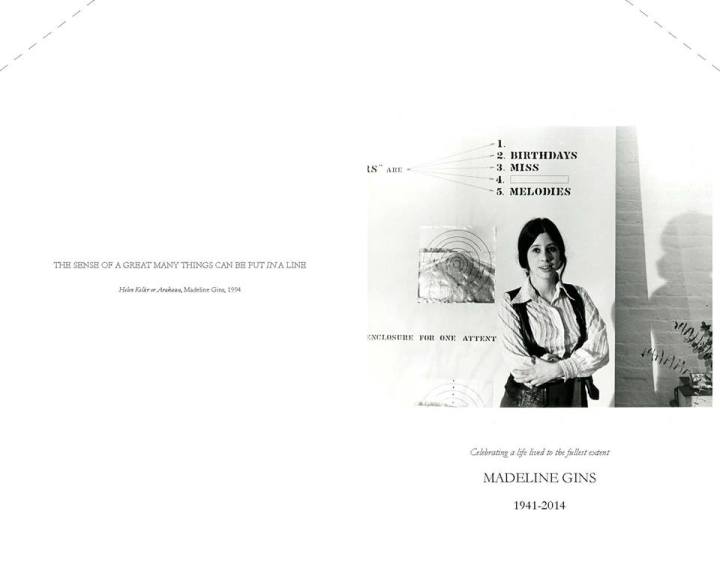
SOME MUSIC:
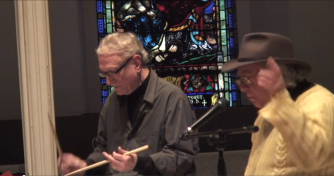 Axial Music for Madeline – 29.3.2014 – George Quasha and Charles Stein – St. Mark’s in the Bowery, NYC
Axial Music for Madeline – 29.3.2014 – George Quasha and Charles Stein – St. Mark’s in the Bowery, NYC
Performed in tribute, using phrases from Gins’ book WHAT THE PRESIDENT WILL SAY AND DO!! (Station Hill Press: Barrytown, 1984).
SOME WORDS:
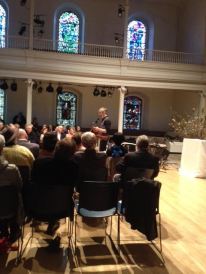 Words for Madeline’s M(or)emorial – 29.3.2014 – Alan Prohm – St. Mark’s in the Bowery, NYC
Words for Madeline’s M(or)emorial – 29.3.2014 – Alan Prohm – St. Mark’s in the Bowery, NYC
Madeline, like Arakawa, may be gone, but she is not done.
I last saw Madeline last July, when she was very close to dying – before a comeback that amazed us more than it surprised. Madeline was incredibly determined and relentless in the face of the relentless, and there was no telling how far she would take this – Life, I mean.
I came to New York, and was hoping to see her. I was staying in a dive in Chinatown, in a plyboard room the exact size of one twin bed. At 6:20 a.m. the phone rang. It was Madeline, and she wanted to know if I wanted to ride uptown right then to meet her. She was receiving a therapeutic treatment and thought I might be interested. It was too early for me, so I thanked her and went back to bed, planning to see her later. Then, while I was asleep, I had this dream:
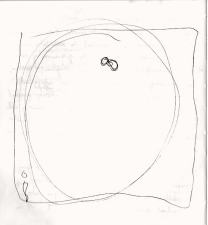 I was in an enormous loft-like space. Three storeys high, red brick, empty volume, huge windows in two adjoining walls. The space was filled with a pearly-amber light. Within this, high up, near the ceiling, floating serenely, was a foetus, its insides palely visible, and its outsides this pearly-amber fluid contained within a membrane that filled the space completely, leaving only, because of its roundness, these narrow gaps in the corners, in one of which I stood, against the red brick wall staring up at this thing through its vast viscuous volume in amazement.
I was in an enormous loft-like space. Three storeys high, red brick, empty volume, huge windows in two adjoining walls. The space was filled with a pearly-amber light. Within this, high up, near the ceiling, floating serenely, was a foetus, its insides palely visible, and its outsides this pearly-amber fluid contained within a membrane that filled the space completely, leaving only, because of its roundness, these narrow gaps in the corners, in one of which I stood, against the red brick wall staring up at this thing through its vast viscuous volume in amazement.
When I woke it was clear to me – this was the architectural body, in gestation.
Madeline wanted many of us to become procedural architects, because she wanted all of us to become architectural bodies. Her trajectory, through poetry, into mixed-medial art, and out of art, into architecture, is unique in literary, art, and architectural history. Driven by a commitment to humanity so demanding that it demanded more of humanity, and more for humanity from the arts and industries that house it, and housing it, teach it, for better or for worse, what it is and can be.
Together with Arakawa, in this inimitable partnership, she presented architecture with a still unanswered challenge: Do more for the body. In fact, do everything for the body. And single/quadruple-handedly invented the field of art-science dedicated to teasing out this more, and getting it built, or born. Procedural architecture is not a style or a game of art, but a challenge, bigger and more convulsive than yet suspected. The premise that architecture is not apart from the bodies it contains, but is their extension, the rest of their being, and that only an architecture as intimate with bodies as the air, or the spirit, can enable them to be the rest of what they are capable of.
…if you study hard and always strive to know the full range of the body’s capabilities, you will in all probability not have to die.
I was once at dinner with Madeline and Arthur Danto, and heard Madeline say, “So, of course you know that the future of philosophy is architecture,” as she was already at the time proof that the future of poetry was architecture. In her career she disposed of a tremendous attunement to the intricacies of meaning-construction, one only a deeply philosophical experimental poet of her calibre could muster – (and as her first book, Word Rain long ago established, she was clearly one of the great experimental poets of our times) – and applied this to a completely new approach to architecture. Architecture designed not for form, not for function, but for the procedures an architecture stages and conducts for/with the body that moves through it, and increasingly as it.
Procedurality as a concept and a challenge, as the basis of an urgently advanced new mission, is as revolutionary to current regimes of art and architectural production as functionalism was to an age of formalism, or abstraction to an age of pictorial realism. Like the first works of those revolutions, procedural architecture cannot yet be recognized from inside current frameworks, as Arakawa and Gins’ difficult reception in many corners continues to demonstrate. But, as seen by the hungry reception their work meets with among new generations exploring for a more in art or architecture, procedurality’s time is still coming. So, watch for it.
I myself have had the pleasure of introducing students of many backgrounds to these ideas and this practice. Artists, architects, poets and dancers, in particular, recognize the opening of a whole new horizon here. And in Helsinki, Tallinn, and Berlin where I have taught, in Australia where Jondi Keane, Russel Hughes and other fine colleagues are working, in Montreal where Erin Manning and Brian Massumi currently have many students engaging bravely with the challenge and promise of procedurality, in Tokyo where Momoyo Homma continues to activate and inspire many through her work at the Mitaka Lofts, and of course here in the US where Joke Post continued to run the office with her design team (in winter 2013/14 this was principally S.T. Luk and Leopold Lambert, with Alistair Noble, Stephen Hepworth, George Bolster and Monica Hofstadter in the larger office team) through the end of Madeline’s time, and now further, the momentum of interest and participation in the project of procedural architecture and a reversible destiny are only growing. In June there will be a large gathering here in the city of just these people, to show just this growth, and the many currents of momentum that will carry the work of Madeline and Arakawa forward.
The Reversible Destiny Foundation exists, and seems insistant on persisting, relentlessly, to spread the legacy and pursue the promise of procedural architecture, and to force the challenge it presents to architecture more generally. The Foundation, now entering a new phase of its own not-dying, will continue the research and construction necessary to realizing this promise, and with it the work and love of these two great spirits that gave it birth.
Madeline, and her Arakawa, may no longer be alive, but they are around. And will be. So, watch for them.

